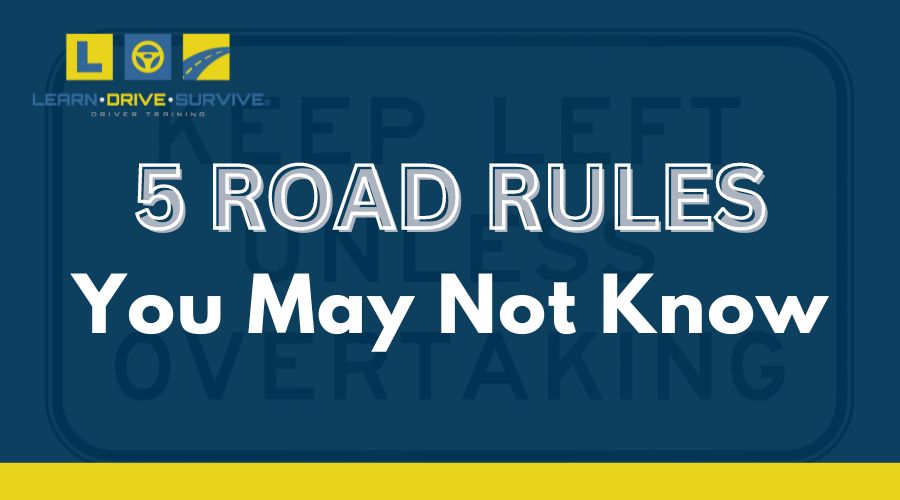5 Road Rules You May Not Know About
Do slower moving vehicles need to keep left in NSW? Do you have to give way to buses leaving a bus stop? Do you have to stop for a yellow light? For many experienced drivers, knowing the road rules in certain situations could be questioned. Navigating through New South Wales’ (NSW) road rules can sometimes feel like deciphering a complex code. While most drivers are aware of the basic road rules and guidelines, some rules are less known yet equally important for safety and compliance. This blog post sheds light on five NSW road rules that might surprise you, ensuring you stay informed and avoid unnecessary penalties.
1. Keeping Left Isn’t Just Courteous, It’s the Law 
In NSW, on roads with a speed limit greater than 80 km/h, drivers must keep left unless overtaking. This regulation eases traffic flow and minimises risks associated with high speed driving. If you are travelling on a milti lane road and the posted speed limit is less than 80km/h, you can travel in either lane. Regardless if overtaking or not. From a safety perspective, by keeping left and using the left lane, you reduce the risk from oncoming traffic travelling over the centre lines.
When sitting your NSW driving test, if you travel in the right lane with a speed limit less than 80 km/h, you will earn yourself a position error. When travelling on multi lane roads, always maintain effective observation skills and readiness for unexpected events. And remember, never travel in the blind spot of another vehicle.
2. Road Rules for Buses – Giving Way is the Way 
Buses have the right of way in all Australian states. The difference is the fines and demerit points depending on where you live. As a driver, you’re required to give way to buses with a ‘Give Way to Buses’ sign and flashing turn signals. You must give way to a bus in the following circumstances;
- displaying the give way sign in a built up area,
- when a bus is leaving a bus stop and is about to enter or proceed in the lane or line of traffic and;
- the bus is in front of the driver.
This rule ensures the punctuality of public transport and the safety of passengers disembarking and boarding.
3. The Yellow Light Conundrum – Proceed with Caution?
Did you know you can be fined for travelling through a yellow (amber) light? Many drivers are tempted to speed up instead of slowing down when they see a yellow light. However, under NSW road rules, you must stop at a yellow traffic light unless it is unsafe to do so. This critical moment can affect reaction times and the safety of driving through an intersection. You must must stop if you can do so safely. Penalties apply for drivers who make no attempt to stop at a yellow light.
when they see a yellow light. However, under NSW road rules, you must stop at a yellow traffic light unless it is unsafe to do so. This critical moment can affect reaction times and the safety of driving through an intersection. You must must stop if you can do so safely. Penalties apply for drivers who make no attempt to stop at a yellow light.
You should never not stop suddenly, and you should never speed up to get through a yellow light. So what is the safest way to travel through an intersection controlled by traffic lights?
1. When approaching the intersection, always check your rear view mirror to see how close the vehicle behind you is.
2. Make sure there is no traffic ‘banked up’ on the other side of the intersection. You don’t want to be stuck in the middle of an intersection obstructing traffic.
3. As you approach the intersection (approx 50 metres away), ease off the acclerator and cover your brake in readiness for the traffic lights to change from green to yellow.
4. If the lights change during this time and there are no vehicles travelling close behind you, slow down and stop.
5. Once you are within a short distance (approx 10-15 metres), commit and travel through the intersection. Refrain from heavy braking as it’s unsafe and chances are you may end up stopping past the stop line.
4. U-Turns at Traffic Lights – Not Always a Green Light 
The road rules for making a U-turn at traffic lights are clear and strict to ensure safety for all road users. In NSW, making a U-turn at traffic lights is only permitted when there’s a ‘U-Turn Permitted’ sign or a green U-turn traffic light displayed. Without this sign or control signal, you’re risking a fine and the safety of oncoming traffic. It’s essential to make informed decisions at intersections, especially when considering a U-turn. No matter what, if you intend on performing a U-turn, make sure it’s safe and legal.
5. Foggy Judgement – The Misuse of Fog Lights
Fog lights are designed for low visibility conditions, and using them in clear weather can dazzle other drivers, potentially leading to distracted driving scenarios. In NSW, it’s an offence to use fog lights unless driving in fog, mist, or other conditions that reduce visibility. It’s common for drivers to turn their fog lights on during poor weather and forget to turn them off once conditions and visibility have improved. But this simple unintentional mistake could cost you $116 for using fog light when not permitted.
Understanding and adhering to these road rules can not only save you from fines but also contribute to a safer driving environment. Remember, it’s not just about knowing the rules but understanding the intent behind them – which is to create a responsible and defensive driving culture. For more insights on safe driving practices, consider enrolling in the NSW Safer Drivers Course.
Stay safe, stay informed, and drive responsibly.

